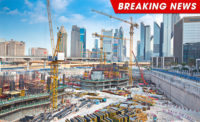AISI Publishes Two New S900-Series Test Standards

The American Iron and Steel Institute (AISI) has published two new test standards in its S900-series. These test standards have been approved by the American National Standards Institute (ANSI) as the American National Standards and are available for downloading free of charge at www.aisistandards.org.
The test standards include:
- AISI S917-17, Test Standard for Determining the Fastener-Sheathing Local Translational Stiffness of Sheathed Cold-Formed Steel Assemblies, 2017 Edition – This new standard provides a method for determining the local translational stiffness supplied by sheathing, fastened to cold-formed steel members. The test method can be used for wall studs braced solely by sheathing to experimentally determine the lateral bracing restraint developed at the fastener-sheathing connection. It may be extended to purlins, girts, joists or any cold-formed steel member in which restraint is provided, in part, by the localized translational stiffness that develops at the connection between a cold-formed steel member and sheathing, such as steel panels, plywood, gypsum board, etc.
- AISI S918-17, Test Standard for Determining the Fastener-Sheathing Rotational Stiffness of Sheathed Cold-Formed Steel Assemblies, 2017 Edition - AISI S918 is a new test standard that provides a method for determining the rotational restraint supplied by sheathing, fastened to cold-formed steel members. When a cold-formed steel member is connected to sheathing, the sheathing can provide beneficial rotational restraint of the member, such as a stud, joist, etc. One direct mechanism for developing such rotational restraint is a combination of bearing between the flange and sheathing, and pull-through resistance at a fastener location, as the member rotates. This mechanical combination may be idealized as a rotational restraint at the fastener location. The rotational restraint provides the primary bracing restraint against distortional buckling.
AISI test standards are updated every five years and facilitate research and development leading to improved state-of-the-art solutions in steel for the construction market. They are often referenced in industry acceptance criteria, and lead the way in establishing the performance characteristics of unique products and applications.
Looking for a reprint of this article?
From high-res PDFs to custom plaques, order your copy today!




